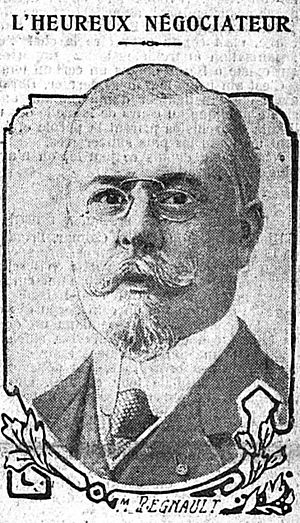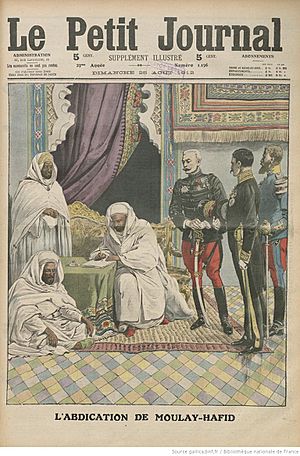Treaty of Fes facts for kids
| Treaty Concluded Between France and Morocco on 30 March 1912, for the Organization of the French Protectorate in the Sherifien Empire Traité conclu entre la France et le Maroc le 30 mars 1912, pour l'organisation du protectorat français dans l'Empire chérifien |
|
|---|---|
| Signed | March 30, 1912 |
| Location | Fes |
| Signatories |
|
|
Part of a series on the
|
|---|
| History of Morocco |
 |
|
|
Classical to Late Antiquity
(8th century BC – 7th century AD) |
|
|
|
|
|
|
Related topics
|
The Treaty of Fes (Arabic: معاهدة فاس, French: Traité de Fès) was a very important agreement signed on March 30, 1912. It was signed by Sultan Abd al-Hafid of Morocco and a French diplomat named Eugène Regnault. The Sultan was forced to sign it.
This treaty officially created the French protectorate in Morocco. A protectorate meant that France would control many parts of Morocco's government. This agreement lasted until March 2, 1956, when Morocco became fully independent.
The treaty allowed France to send its military into parts of Morocco. France said this was to protect the Sultan and keep order. However, France gained a lot of real power. The Sultan and his government still seemed to be in charge, but they had very little actual control.
Under the treaty, a French official called the Resident-General had almost total power. This person controlled both Morocco's foreign affairs and its internal matters. Only the Resident-General could represent Morocco to other countries. The Sultan could still sign official orders (called dahirs), but these orders had to be approved by the Resident-General first.
When people in Morocco found out about the treaty, they were very angry. This led to immediate and strong protests, including the Intifada of Fes.
Contents
Why the Treaty Happened
Morocco's Challenges Before 1912
Morocco faced many problems before the Treaty of Fes. After losing the Franco-Moroccan War, Morocco signed another treaty in 1856. This treaty made it harder for the Moroccan government (called the Makhzen) to collect money from customs duties. This was a main source of income for the country.
Then, after another war with Spain (1859–60), Morocco had to pay a huge amount of money to Spain. This payment was so large that Morocco had to borrow a massive loan from Britain. This put the Makhzen deeply in debt.
More Europeans, like advisors, doctors, and business people, came to Morocco after a meeting in Madrid in 1880. This meeting was called by Sultan Hassan I because France and Spain were misusing a system that protected some Moroccan citizens. More than half of the Makhzen's money was spent abroad. This money went to pay off war debts and to buy weapons and other goods.
From 1902 to 1909, Morocco bought much more than it sold to other countries. This created a large trade deficit. The value of Moroccan money also dropped a lot. Morocco had to take out many loans to try and balance its budget. In 1904, France gave the Makhzen a huge loan, which was guaranteed by Morocco's customs money.
A Moroccan historian, Abdallah Laroui, said that the more the leaders borrowed, the poorer the people became. Morocco also suffered from a famine from 1903 to 1907. There were also rebellions led by people like El-Rogui and Mulai Ahmed er Raisuni. In 1908, Abd al-Hafid took the throne from his brother Abd al-Aziz in a coup.
European Agreements About Morocco
In 1904, the United Kingdom, Italy, and France made secret agreements among themselves. These agreements, known as the Entente Cordiale, decided how to divide up North Africa into areas of influence. They did this without asking the Sultan of Morocco. France was given control over Morocco.
In 1906, the Treaty of Algeciras made France's special position in Morocco official. It also confirmed France's right to collect customs money from Moroccan ports. This treaty gave France more power than other European countries in Morocco.
After a big event called the Agadir Crisis in 1911, Germany agreed that France could have control in Morocco. In return, Germany received some land in French Equatorial Africa. This land became part of the German colony of Kamerun. However, Germany only held this land for a short time before losing it in World War I. As part of this deal, Germany also gave France a small piece of land in what is now Chad.
The Moroccan Government's View
When Sultan Abdelaziz became ruler in 1894 at age 16, Europeans became his main advisors. Local leaders in Morocco also started to act more independently from the Sultan. Sultan Abdelaziz was removed from power in 1908.
Law and order continued to get worse under the next Sultan, Abdelhafid. He later gave up his throne to his brother Yusef after signing the Treaty of Fes.
Makhzen officials thought that the protectorate system in Morocco would be like British Egypt. They hoped Morocco would keep a lot of control over its own internal government and justice system. However, the Treaty of Fes was actually based on an earlier treaty from 1881. That treaty had made Tunisia a French protectorate and greatly limited the ruler's power.
An interim government, led by Abdelhafid's brother, Ziin al-'Aabidiin, also put pressure on Abdelhafid. This brother was made sultan in Meknes on April 17, 1911.
Eugène Regnault, a French diplomat, arrived in Fes on March 24, 1912, with the Treaty of Fes ready. He had held long meetings in Paris to prepare it.
In March 1912, talks took place at the Royal Palace in Fes. Sultan Abd al-Hafid of Morocco and Eugène Regnault were there. Abdelqader Benghabrit, a translator for the French, helped with the discussions. On March 29, the talks lasted for six hours, from 6:00 pm until midnight. French soldiers surrounded the city during these talks. The next day, March 30, the Treaty of Fes was signed. This treaty officially created the French Protectorate in Morocco.
What the Treaty Changed
The Treaty of Fes gave France control over many areas in Morocco. This included laws, the military, foreign policy, and legal matters for non-Moroccan citizens. The Moroccan government was still technically in charge of its own citizens. However, Moroccan nationalists argued that France still had a lot of influence over all Moroccan affairs because of the treaty.
Another treaty, signed on November 27, 1912, was between France and Spain. This agreement created the Spanish protectorate in Morocco. Spain gained control over areas like the Rif and Cape Juby. In these areas, the Sultan was still officially the ruler. He was represented by a special official under the control of the Spanish high commission. This treaty also allowed a Spanish company to mine iron in Mount Uixan. The company was also allowed to build a railroad to connect the mines to Melilla.
Key Points of the Treaty
The Treaty of Fes had several important articles:
- Article I: France and the Sultan agreed to create a new system in Morocco. This system would bring in reforms in areas like government, justice, education, economy, and military. The new system would still respect the Sultan's religious role and Muslim traditions.
- Article II: The Sultan agreed that France could send its military into Moroccan territory. This was for keeping order and protecting trade. France could also act as a police force on land and in Moroccan waters.
- Article III: France promised to support the Sultan. This support was against any danger to him, his throne, or the peace of his country. This promise also extended to the Sultan's future heirs.
- Article IV: New rules and changes to old rules for the protectorate would be made. These would be suggested by the French government and then issued by the Sultan or officials he chose.
- Article V: France would have a Resident-General in Morocco. This person would represent all of France's power in Morocco. The Resident-General would be the only link between the Sultan and foreign representatives. They would also handle all matters concerning foreigners in Morocco. The Resident-General could approve and announce all decrees made by the Sultan.
- Article VI: French diplomats and consuls would represent and protect Moroccan citizens and their interests in other countries. The Sultan promised not to make any international agreements without France's approval.
- Article VII: France and the Sultan would work together to reorganize Morocco's finances. This would ensure that Morocco could pay its debts and collect its income regularly.
- Article VIII: The Sultan promised not to take out any new loans, either public or private, without France's permission. He also could not grant any new business deals or concessions without France's approval.
- Article IX: The agreement had to be approved by the French government. The official approval document would be given to the Sultan as soon as possible.
See also
 In Spanish: Tratado de Fez para niños
In Spanish: Tratado de Fez para niños
- Mnebhi Palace (where the Treaty was signed)
- Moroccan Debt Administration
- History of Morocco
- French Morocco
- Spanish Morocco
|




